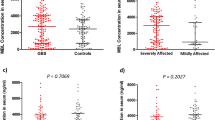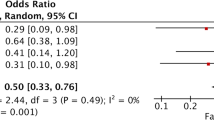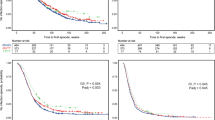Abstract
Mannose-binding lectin (MBL) plays an important role in the early stages of primary infections and during the decay of maternal antibodies in infants. Various studies have looked at the relation between serum MBL concentrations, MBL gene alterations and susceptibility to infections. We investigated the distribution of variant MBL alleles in 626 unrelated adults from sub-Saharan African countries and looked for a potential relation between these alleles and the incidence, prevalence and death rate of tuberculosis for sub-Saharan Africa. We also evaluated the relation between MBL genotypes and susceptibility to HIV-1 infection in 188 Gabonese adults. We found that (i) the prevalence of the common variant MBL alleles is correlated with the incidence of tuberculosis in sub-Saharan Africa (r=0.565), (ii) the mutant MBL G57E allele, in either the homozygous or compound heterozygous state, is associated with susceptibility to HIV-1 infection in the Gabonese population (P=0.019).Our data plus those in the literature suggest that individuals who are homozygous for the mutant MBL alleles display increased susceptibility to infections. Interestingly, we found that individuals who are heterozygous for MBL mutations are much less susceptible to infections than those who are homozygous for the wild-type MBL allele.
This is a preview of subscription content, access via your institution
Access options
Subscribe to this journal
Receive 6 digital issues and online access to articles
$119.00 per year
only $19.83 per issue
Buy this article
- Purchase on Springer Link
- Instant access to full article PDF
Prices may be subject to local taxes which are calculated during checkout


Similar content being viewed by others
References
Sastry K, Herman GA, Day L et al. The human mannose-binding protein gene. J Exp Med 1989; 170: 1175–1189.
Taylor ME, Brickell PM, Craig RK, Summerfield JA . Structure and evolutionary origin of the gene encoding a human serum mannose-binding protein. Biochem J 1989; 262: 763–771.
Kuhlman M, Joiner K, Ezekowitz RAB . The human mannose-binding protein functions as an opsonin. J Exp Med 1989; 169: 1733–1745.
Matsushita M, Fujita T . Activation of the classical complement pathway by mannose-binding protein in association with a novel C1s-like serine protease. J Exp Med 1992; 176: 1497–1502.
Turner MW . Mannose-binding lectin: the pluripotent molecule of the innate immune system. Immunol Today 1996; 17: 532–540.
Super M, Thiel S, Lu J, Levinsky RJ, Turner MW . Association of low levels of mannan-binding protein with a common defect of opsonisation. Lancet 1989; i: 1236–1239.
Sumiya M, Super M, Tabona P et al. Molecular basis of opsonic defect in immunodeficient children. Lancet 1991; 337: 1569–1570.
Lipscombe RJ, Sumiya M, Hill AVS et al. High frequencies in African and non-African populations of independent mutations in the mannose binding protein gene. Hum Mol Genet 1992; 1: 709–715.
Madsen HO, Garred P, Kurtzhals JAL et al. A new frequent allele is the missing link in the structural polymorphism of the human mannan-binding protein. Immunogenetics 1994; 40: 37–44.
Madsen HO, Garred P, Thiel S et al. Interplay between promoter and structural gene variants control basal serum level of mannan-binding protein. J Immunol 1995; 155: 3013–3020.
Garred P, Madsen HO, Kurtzhals JAL et al. Diallelic polymorphism may explain variations of the blood concentration of mannan-binding protein in Eskimos, but not in Black Africans. Eur J Immunogenet 1992; 19: 403–412.
Hoal-Van Helden EG, Epstein J, Victor TC et al. Mannose-binding protein B allele confers protection against tuberculous meningitis. Pediat Res 1999; 45: 459–464.
Bellamy R, Ruwende C, Mcadam KPWJ et al. Mannose binding protein deficiency is not associated with malaria, hepatitis B carriage nor tuberculosis in Africans. Q J Med 1998; 91: 13–18.
Ezekowitz RAB, Kuhlman M, Groopman JE, Byrn RA . A human serum mannose-binding protein inhibits in vitro infection by the human immunodeficiency virus. J Exp Med 1989; 169: 185–196.
Garred P, Madsen HO, Balslev U et al. Susceptibility to HIV infection and progression of AIDS in relation to variant alleles of mannose-binding lectin. Lancet 1997; 349: 236–240.
Prohaszka Z, Thiel S, Ujhelyi E, Szlavik J, Banhegyi D, Fust G . Mannan-binding lectin serum concentrations in HIV-infected patients are influenced by the stage of disease. Immunol Lett 1997; 58: 171–175.
Dye C, Scheele S, Dolin P, Pathania V, Raviglione . Global burden of tuberculosis: estimated incidence, prevalence and mortality by country. JAMA 1999; 282: 677–686.
Lipscombe RJ, Beatty DW, Ganczakowski M et al. Mutation in the human mannose-binding protein gene: frequencies in several population groups. Eur J Hum Genet 1996; 4: 13–19.
Madsen HO, Satz ML, Hogh B, Svejgaard A, Garred P . Different molecular events result in low protein levels of mannan-binding lectin in populations from southeast Africa and South America. J Immunol 1998; 161: 3169–3975.
Lapouméroulie C, Acuto S, Rouabhi F, Labie D, Krishnamoorthy R, Bank A . Expression of a beta thalassemia gene with abnomal splicing. Nucleic Acids Res 1987; 15: 8195–8204.
Garred P, Richter C, Andersen AB et al. Mannan-binding lectin in the sub-Saharan HIV and tuberculosis epidemics. Scand J Immunol 1997; 46: 204–208.
Schorey JS, Carroll MC, Brown EJ . A macrophage invasion mechanism of pathogenic mycobacteria. Science 1997; 277: 1091–1093.
Garred P, Harboe M, Oettinger T, Koch C, Svejgaard A . Dual role of mannan-binding protein in infections: another case of heterosis? Eur J Immunogenet 1994; 21: 125–131.
Santos IK, Costa CH, Krieger H et al. Mannan-binding lectin enhances susceptibility to visceral leishmaniasis. Infect Immun 2001; 69: 5212–5215.
Saifuddin M, Hart ML, Gewurz H, Zhang Y, Spear GT . Interaction of mannose-binding lectin with primary isolates of human immunodeficiency virus type 1. J Gen Virol 2000; 81: 949–955.
Maas J, de Roda Husman AM, Brouwer M et al. Presence of the variant mannose-binding lectin alleles associated with slower progression to AIDS. AIDS 1998; 12: 2275–2280.
Neonato MG, Lu CY, Guilloud-Bataille M et al. Genetic polymorphism of the mannose-binding protein gene in children with sickle cell disease: identification of three new variant alleles and relationship to infections. Eur J Hum Genet 1999; 7: 679–686.
Garred P, Madsen HO, Hofmann B, Svejgaard A . Mannose-binding protein genotypes and recurrent infection. Lancet 1995; 346: 1629–1630.
Summerfield JA, Ryder S, Sumiya M et al. Mannose binding protein gene mutations associated with unusual and severe infections in adults. Lancet 1995; 345: 886–889.
Matsushita M, Hijikata M, Ohta Y et al. Hepatitis C virus infection and mutations of mannose-binding lectin gene MBL. Arch Virol 1998; 143: 645–651.
Garred P, Madsen HO, Halberg P et al. Mannose-binding lectin polymorphisms and susceptibility to infection in systemic lupus erythematosus. Arthritis Rheum 1999; 42: 2145–2152.
McBride MO, Fischer PB, Sumiya M et al. Mannose-binding protein in HIV-seropositive patients does not contribute to disease progression or bacterial infections. Int J STD AIDS 1998; 9: 683–688.
Gabolde M, Muralitharan S, Besmond C . Genotyping of the three major allelic variants of the human mannose-binding lectin gene by denaturing gradient gel electrophoresis. Hum Mutat 1999; 14: 80–83.
Acknowledgements
We thank N Gerard, M Makuwa and C Tevi-Benissan for providing DNA samples, F Lekoulou, R Moukagni, A Moussavou, R Nabias and J Lansoud-Soukate for assistance with the field work, and A Luty for reading the manuscript. We are indebted to the subjects and especially the HIV patients for their participation in this study. This study was funded by INSERM and by the Centre International de Recherches Médicales (CIRMF-Gabon), which is supported by the Government of Gabon, ELF-Gabon and the Ministère Français des Affaires Etrangères.
Author information
Authors and Affiliations
Corresponding author
Rights and permissions
About this article
Cite this article
Mombo, L., Lu, C., Ossari, S. et al. Mannose-binding lectin alleles in sub-Saharan Africans and relation with susceptibility to infections. Genes Immun 4, 362–367 (2003). https://doi.org/10.1038/sj.gene.6363979
Published:
Issue Date:
DOI: https://doi.org/10.1038/sj.gene.6363979
Keywords
This article is cited by
-
HLA Class I and II alleles, heterozygosity and HLA-KIR interactions are associated with rates of genital HSV shedding and lesions
Genes & Immunity (2016)
-
MBL2 genetic polymorphisms and HIV-1 mother-to-child transmission in Zambia
Immunologic Research (2016)
-
Mannose-binding lectin two gene polymorphisms and tuberculosis susceptibility in Chinese population: A meta-analysis
Journal of Huazhong University of Science and Technology [Medical Sciences] (2013)
-
Disseminated Tuberculosis in a Patient with Hereditary C1-inhibitor Deficiency
Infection (2008)



